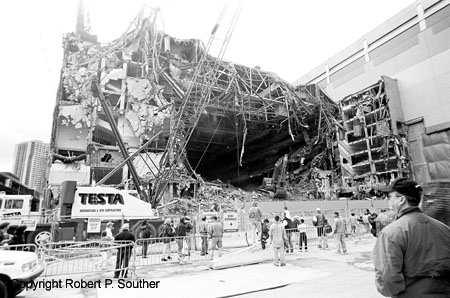
The Garden as it stood on Causeway St.
I am 26 years old and I've been a Bruins fan for as long as I can remember. I've been to the original Boston Garden for many Bruins and Celtics games and can still remember sitting in the old balcony seats, which was basically hung right over the ice/court. It was magical and those who were there through the 1972 Stanley Cup run or the 1980's NBA Championships can attest to that. Unfortunately, in 1997 the Boston Garden was finally demolished to make way for the
Shawmut Center/
Fleetcenter/TD Bank North Garden/TD Garden/(insert new name here), but the legend and lore of the Boston Garden will never be forgotten.
Built in November of 1928, the Boston Madison Square Garden (later cut down to Boston Garden) was the brain-child of boxing promoter Tex Ricard, who had dreams of making it a miniature Madison Square Garden (hence the name). Tex built the arena specifically for boxing matches and set the seats so that fans could see the "sweat on the boxer's brow". This led seats to be closer to the action so when both the NHL and NBA started playing there, there was a large home advantage.
 Dubbed
Dubbed "
The House That Russell Built"
The Garden housed one of the biggest sports legends in Boston, its parquet floor. The floor was initially installed at the Boston Arena (Matthew's Arena now at Northeastern) and moved to the Boston Garden in 1952. It was a distinct advantage for the Celtics.
"The parquet floor is synonymous with the Celtics. It is a good floor, a very good floor. The so-called dead spots on the floor? If teams felt it was a poor floor, I used it for an advantage by playing with their minds. That usually worked. When teams did beat us on the rare occasion, they never complained. The strange thing was that there were more dead spots in old Madison Square Garden than in Boston. Believe me, I played and coached there on many occasions; I know." - Red
Auerbach The Garden in its black and gold splendor
The Garden in its black and gold splendorThe Garden, however, wasn't without it's flaws. The air conditioning was non-
existent and it was never more prevalent than during a Boston Bruins playoff game where fog clouded up the entire arena. The air conditioning wasn't the only problem though as the electrical system was also a mess. On May 24, 1988 a power transformer blew up during Game 4 of the finals series between the Bruins and the
Oilers. Two years later on May 15, 1990 the lights went out during an overtime finals game again between the Bruins and Edmonton
Oilers. This happened because the game went into 3 overtimes and lasted around 6 hours long and the faulty wiring of the Garden couldn't handle the length of the game.
The actual hockey rink itself was also an issue as it was undersized due to the NHL not having size regulations at the time of its installation. The rink was 9 feet shorter and 2 feet narrower than regulation size which gave the Bruins a distinct advantage.
Although the Garden had many flaws, what happened inside the building will never be forgotten. The 1972 Stanley Cup Championship, the 1980 Celtics dynasty, the epic rock concerts with The Who after being arrested in Montreal the night before, James Brown playing on the night Martin Luther King was assassinated and many more memories.
 The demolition of an iconic arena
The demolition of an iconic arena
Although the Garden is gone, it will never be forgotten. Often imitated, never duplicated, the Garden will live on as one of, if not the, greatest arena in sports history. And with this friends, I leave you the greatest Garden image of all time:



 The Garden as it stood on Causeway St.
The Garden as it stood on Causeway St.
 J said...
J said...
